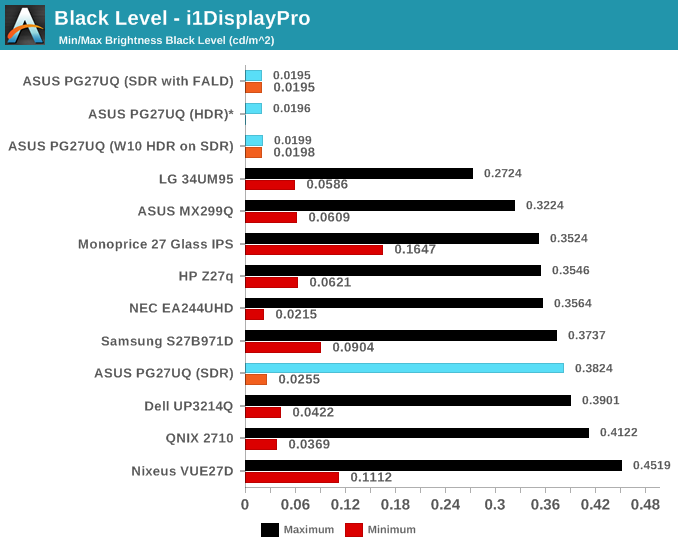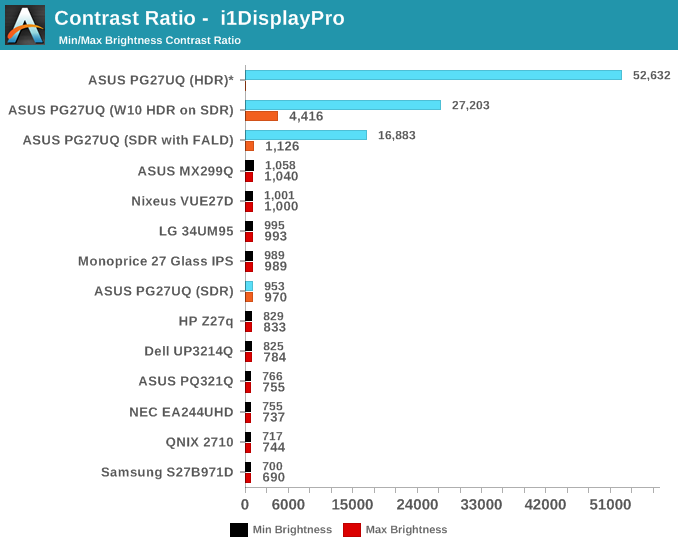The Asus ROG Swift PG27UQ G-SYNC HDR Monitor Review: Gaming With All The Bells and Whistles
by Nate Oh on October 2, 2018 10:00 AM EST- Posted in
- Monitors
- Displays
- Asus
- NVIDIA
- G-Sync
- PG27UQ
- ROG Swift PG27UQ
- G-Sync HDR
Brightness and Contrast
Going straight into the brightness and contrast metrics, we know HDR's calling card is to permit those bright whites and dark blacks. For DisplayHDR 1000, and UHD Premium, 1000 nits (the common non-SI term for cd/m2) is the requirement. So for brightness of white levels, it's no surprise that in HDR mode the PG27UQ reaches that coveted mark.
Outside of HDR, brightness is also useful in gauging visibility/usability in conditions of bright and direct ambient light, i.e. outdoors. For moderately lit indoor use, the typical 200 to 300 nit range of desktop monitors is more than sufficient. In terms of factory defaults, the PG27UQ is set at 80 for brightness, which is around 266 nits. 1000 nits is much too bright for day-to-day usage, as is 500 nits.

*In HDR mode, there is an adjustable 'reference white' setting, defaulted at 80 nits, instead of a brightness setting. At that default setting, the PG27UQ displayed the HDR test pattern at 1032 nits.
Because HDR has a static 'reference white' level instead of brightness, there isn't really an equivalent to minimum brightness white level as it isn't utilized in the same way; for the PG27UQ, reference white can be set between 20 to 300 nits.
Otherwise, enabling the Windows 10 'HDR and Wide Color Gamut' mode puts the monitor into its HDR mode; additionally, that Windows 10 setting provides a brightness slider governing SDR content while in HDR mode. So at 100% SDR brightness, the display pushes past 500 nits. For users, it works nicely to avoid SDR dimness when HDR is enabled, and also providing the option to boost up to much higher brightness if desired.

*Represents black levels corresponding to the default 'reference white' setting of 80 nits.
IPS-type panels are often known for their 'backlight bleed' and so relatively higher black levels. Without its local dimming capability, the PG27UQ isn't much of an exception. Enabling variable backlighting (FALD) in the OSD brings the black levels to HDR tier performance, and can be enabled on SDR mode at the cost of maximum brightness white levels.

*Contrast ratios calculated from default reference white of 80 nits
The good range between bright whites and dark blacks translate into high contrast ratios for the PG27UQ. While we don't have any other HDR monitors for comparison, the contrast ratios are really in their own class, especially as only HDR content will take advantage of the brightness and be (properly) displayed. Otherwise, in pure SDR mode, the PG27UQ resembles a solid IPS-type SDR monitor. Just enabling the direct LED backlighting in SDR mode improves contrasts considerably on the strength of its black levels.










91 Comments
View All Comments
lilkwarrior - Monday, October 8, 2018 - link
OLED isn't covered by VESA HDR standards; it's far superior picture quality & contrast.QLED cannot compete with OLED at all in such things. I would very much get a Dolby Vision OLED monitor than a LED monitor with a HDR 1000 rating.
Lolimaster - Tuesday, October 2, 2018 - link
You can't even call HDR with a pathetic low contrast IPS.resiroth - Monday, October 8, 2018 - link
Peak luminance levels are overblown because they’re easily quantifiable. In reality, if you’ve ever seen a recent LG TV which can hit about 900 nits peak that is too much. https://www.rtings.com/tv/reviews/lg/c8It’s actually almost painful.
That said I agree oled is the way to go. I wasn’t impressed by any LCD (FALD or not) personally. It doesn’t matter how bright the display gets if it can’t highlight stars on a night sky etc. without significant blooming.
Even 1000 bits is too much for me. The idea of 4000 is absurd. Yes, sunlight is way brighter, but we don’t frequently change scenes from night time to day like television shows do. It’s extremely jarring. Unless you like the feeling of being woken up repeatedly in the middle of the night by a flood light. It’s a hard pass.
Hxx - Saturday, October 6, 2018 - link
the only competition is Acer which costs the same. If you want Gsync you have to pony up otherwise yeah there are much cheaper alternatives.Hixbot - Tuesday, October 2, 2018 - link
Careful with this one, the "whistles" in the article title is referring to the built-in fan whine. Seriously, look at the newegg reviews.JoeyJoJo123 - Tuesday, October 2, 2018 - link
"because I know"I wouldn't be so sure. Not for Gsync, at least. AU Optronics is the only panel producer for monitor sized displays that even gives a flip about pushing lots of high refresh rate options on the market. A 2560x1440 144hz monitor 3 years ago still costs just as much today (if not more, due to upcoming China-to-US import tariffs, starting with 10% on October 1st 2018, and another 15% (total 25%) in January 1st 2019.
High refresh rate GSync isn't set to come down anytime soon, not as long as Nvidia has a stranglehold on GPU market and not as long as AU Optronics is the only panel manufacturer that cares about high refresh rate PC monitor displays.
lilkwarrior - Monday, October 8, 2018 - link
Japan Display plans to change that in 2019. IIRC Asus is planning to use their displays for a portable Professional OLED monitor.I would not be surprised they or LG created OLED gaming monitors from Japan Display that's a win-win for gamers, Japan Display, & monitor manufacturers in 2020.
Alternatively they surprise us with MLED monitors that Japan Display also invested in + Samsung & LG.
That's way better to me than any Nano-IPS/QLED monitor. They simply cannot compete.
Impulses - Tuesday, October 2, 2018 - link
I would GLADLY pay the premium over the $600-1,000 alternatives IF I thought I was really going to take advantage of what the display offers in the next 2 or even 4 years... But that's the issue. I'm trying to move away from SLI/CF (2x R9 290 atm, about to purchase some sort of 2080), not force myself back into it.You're gonna need SLI RTX 2080s (Ti or not) to really eke out frame rates fast enough for the refresh rate to matter at 4K, chances are it'll be the same with the next gen of cards unless AMD pulls a rabbit out of a hat and quickly gets a lot more competitive. That's 2-3 years easy where SLI would be a requirement.
HDR support seems to be just as much of a mess... I'll probably just end up with a 32" 4K display (because I'm yearning for something larger than my single 16:10 24" and that approaches the 3x 24" setup I've used at times)... But if I wanted to try a fast refresh rate display I'd just plop down a 27" 1440p 165Hz next to it.
Nate's conclusion is exactly the mental calculus I've been doing, those two displays are still less money than one of these and probably more useful in the long run as secondary displays or hand me down options... As awesome as these G-Sync HDR displays may be, the vendor lock in around G-Sync and active cooling makes em seem like poor investments.
Good displays should last 5+ years easy IMO, I'm not sure these would still be the best solution in 3 years.
Icehawk - Wednesday, October 3, 2018 - link
Grab yourself an inexpensive 32" 4k display, decent ones are ~$400 these days. I have an LG and it's great all around (I'm a gamer btw), it's not quite high end but it's not a low end display either - it compares pretty favorably to my Dell 27" 2k monitor. I just couldn't see bothering with HDR or any of that other $$$ BS at this point, plus I'm not particularly bothered by screen tearing and I don't demand 100+ FPS from games. Not sure why people are all in a tizzy about super high FPS, as long as the game runs smoothly I am happy.WasHopingForAnHonestReview - Saturday, October 6, 2018 - link
You dont belong here, plebian.